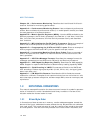
1-6 Vol. 3
ABOUT THIS MANUAL
Chapter 30 — Performance Monitoring. Describes the Intel 64 and IA-32 archi-
tectures’ facilities for monitoring performance.
Appendix A — Performance-Monitoring Events. Lists architectural performance
events. Non-architectural performance events (i.e. model-specific events) are listed
for each generation of microarchitecture.
Appendix B — Model-Specific Registers (MSRs). Lists the MSRs available in the
Pentium processors, the P6 family processors, the Pentium 4, Intel Xeon, Intel Core
Solo, Intel Core Duo processors, and Intel Core 2 processor family and describes
their functions.
Appendix C — MP Initialization For P6 Family Processors. Gives an example of
how to use of the MP protocol to boot P6 family processors in n MP system.
Appendix D — Programming the LINT0 and LINT1 Inputs. Gives an example of
how to program the LINT0 and LINT1 pins for specific interrupt vectors.
Appendix E — Interpreting Machine-Check Error Codes. Gives an example of
how to interpret the error codes for a machine-check error that occurred on a P6
family processor.
Appendix F — APIC Bus Message Formats. Describes the message formats for
messages transmitted on the APIC bus for P6 family and Pentium processors.
Appendix G — VMX Capability Reporting Facility. Describes the VMX capability
MSRs. Support for specific VMX features is determined by reading capability MSRs.
Appendix H — Field Encoding in VMCS. Enumerates all fields in the VMCS and
their encodings. Fields are grouped by width (16-bit, 32-bit, etc.) and type (guest-
state, host-state, etc.).
Appendix I — VM Basic Exit Reasons. Describes the 32-bit fields that encode
reasons for a VM exit. Examples of exit reasons include, but are not limited to: soft-
ware interrupts, processor exceptions, software traps, NMIs, external interrupts, and
triple faults.
1.3 NOTATIONAL CONVENTIONS
This manual uses specific notation for data-structure formats, for symbolic represen-
tation of instructions, and for hexadecimal and binary numbers. A review of this
notation makes the manual easier to read.
1.3.1 Bit and Byte Order
In illustrations of data structures in memory, smaller addresses appear toward the
bottom of the figure; addresses increase toward the top. Bit positions are numbered
from right to left. The numerical value of a set bit is equal to two raised to the power
of the bit position. Intel 64 and IA-32 processors are “little endian” machines; this


















